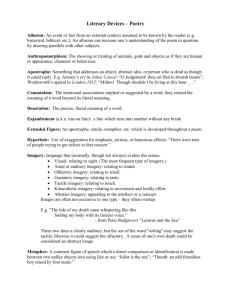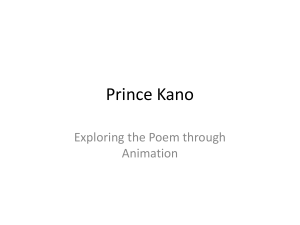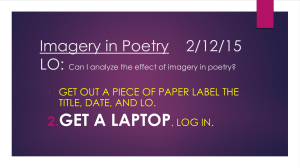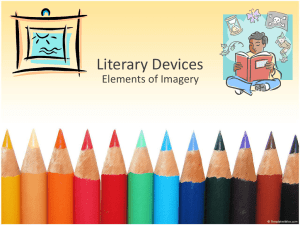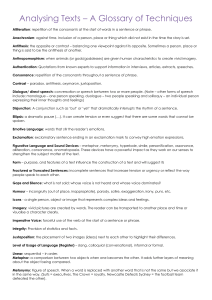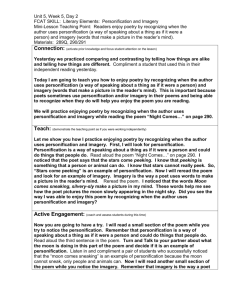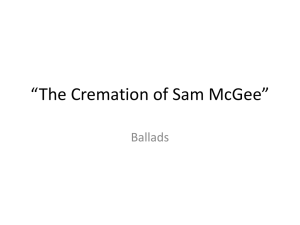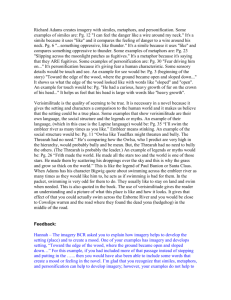Poetic terms and literary devices
advertisement
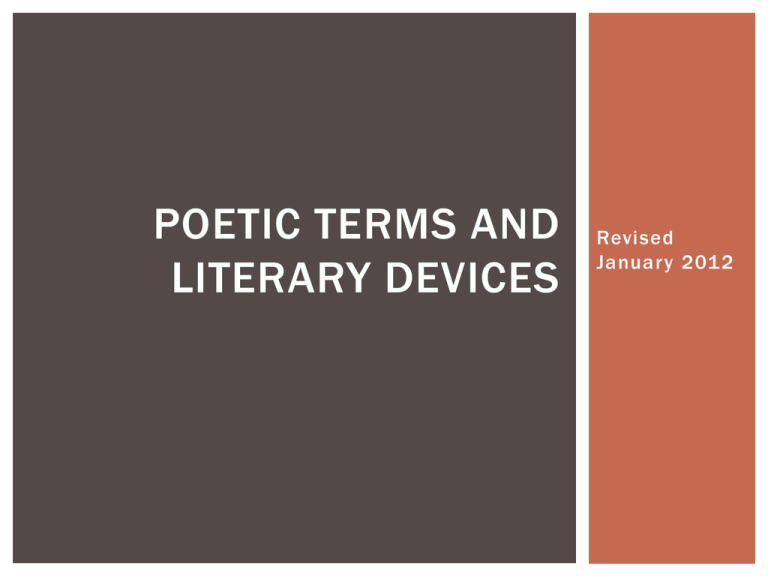
POETIC TERMS AND LITERARY DEVICES Revised January 2012 POETIC DEVICES Literature is developed through the use of what we call “literary elements.” A lot of these will sound familiar to you, but we’re going to introduce some new poetic terms that you’ll need to know throughout high school. TYPES OF IMAGERY Imagery in literature, whether it’s poetry or prose, is the use of words to “paint a picture” or to create a certain effect on the reader. Imagery is developed through particular WORD CHOICE, also known as diction . TYPES OF IMAGERY Imagery helps the author to create a certain mood or tone in his writing. CONSIDER THE FOLLOWING: “The weather was foggy.” TYPES OF IMAGERY Imagery helps the author to create a certain mood or tone in his writing. CONSIDER THE FOLLOWING: “The fog curled about the street like a cat, unfurling its limbs and spreading out.” TYPES OF IMAGERY Imagery is developed through some old friends: SIMILE METAPHOR PERSONIFICATION HYPERBOLE “When I’m gone, I’ll miss you like a child misses her blanket.” -Fergie “She’s as cold as ice, willing to sacrifice our love.” SOME OLD FRIENDS: SOME FAMOUS SIMILES “I love you like a fat kid loves cake.” -50 cent THE SIMILE Comparing two things using “like” or “as” “You’ll be the prince and I’ll be the princess. It’s a love story, baby, just say yes.” -Taylor Swift “Baby, you’re a firework! Come on, let your colors burst.” -Katy Perry SOME OLD FRIENDS: SOME FAMOUS METAPHORS “We’re just two lost souls swimming in a fish bowl year after year.” -Pink Floyd METAPHOR Comparing two things without using like or as. “We take sour sips from life’s lush lips.” -Fall Out Boy “This heart will start a riot in me.” -Paramore SOME OLD FRIENDS: SOME FAMOUS PERSONIFICATION “I get 1 ,000 hugs from 10,000 lightning bugs as they try to teach me how to dance.” -Owl City PERSONIFICATION Giving things or animals humanlike traits. “Cause, baby, I’d walk 1 ,000 miles if I could just see you.” -Vanessa Carlton “Your soul is an appalling dump -heap, overflowing with the most disgraceful assortment of rubbish imaginable!” -from The Grinch SOME OLD FRIENDS: SOME FAMOUS PERSONIFICATION “Stronger than 10 regular men, definitely.” -Genie, about Aladdin HYPERBOLE Exaggeration using words to emphasize a trait. SOUND DEVICES… You’ve heard, of course, of rhyming and alliteration. These devices are used in poetry and prose to create a certain sound for the reader. In these cases, the important part isn’t what the words mean, but how they sound—by themselves AND in connection with the words that surround them. SOUND DEVICES… Sound devices , then, are literary devices that contribute to the way that a poem sounds when it is read. But what’s the purpose? … to sound fun? … to make things dif ficult? THE PURPOSE OF SOUND DEVICES Just like with imagery, certain sound devices have their own purposes in literature. They are meant to contribute to the effect that the poem has on the reader—the overall picture, image, mood, or tone created by a piece. PURPOSE Used to create a faster rhythm in a poem or story Used to mimic the action taking place Used to create an image of “choppiness” in the piece SOUND DEVICES EXAMPLES “She sells seashells by the seashore.” “Peter Piper picked a pack of pickled peppers.” ALLITERATION Repetition of first letter of the word. Creates a sort of “tongue twister.” PURPOSE Used to create a smoother rhythm in a poem or story Used to mimic the action taking place Makes the poem feel more mesmerizing, like a song or lullaby—gives a dreamy (or creepy, or ominous) mood. SOUND DEVICES EXAMPLE He clasps the crag with crooked hands Close to the sun in lonely lands Ringed with the azure world, he stands “Hear the mellow wedding bells.” ASSONANCE Repetition of vowel sounds in words. PURPOSE Used alongside rhyme or sometimes as a kind of replacement for rhymes Used to mimic the action taking place —in the case above, makes the rhyming more ef fective SOUND DEVICES EXAMPLE Rap rejects my tape deck, ejects projectile Whether Jew or Gentile, I rank top percentile, Many styles, More powerful than gamma rays My grammar pays, like Carlos Santana plays CONSONANCE Repetition of consonant sounds in words. PURPOSE To give the reader a vivid picture of the way the action in the poem or story sounds. Helps reader to imagine the scene more accurately. SOUND DEVICES EXAMPLE The bee buzzed throughout the house. I heard the plop of the potato as it hit the water. VS. I heard the swish of the diver as she hit the water. (T WO DIFFERENT IMPRESSIONS, made more specific by the onomatopoeia). ONOMATOPOEIA Words that sound like their meaning. PURPOSE To lend emphasis to the statements being repeated. To give the impression that something can be many things at once. SOUND DEVICES EXAMPLE “I would not eat them in a house I would not eat them with a mouse I would not eat them in a chair I would not eat them anywhere.” “It was the best of times, it was the worst of times, it was the era…” -From A Tale of Two Cities ANAPHORA Repetition of a certain word at the beginning of lines.


